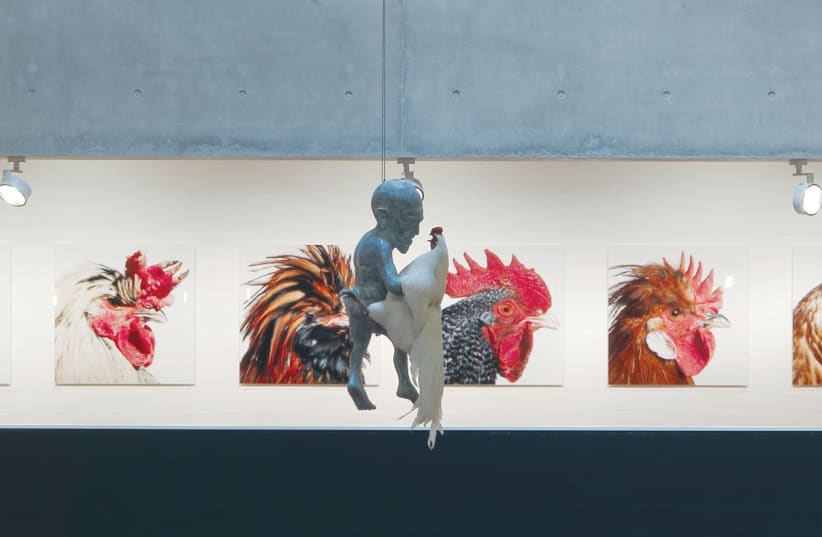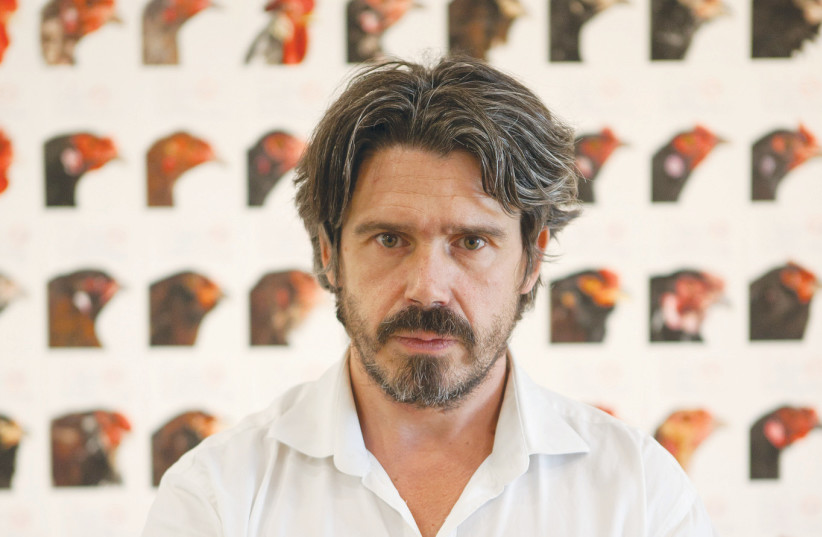The Jerusalem Biennale is back. One of the country’s major expositions of visual works of art will take place, for the fifth time, November 11 through December 30 with its, by now, regular quantitatively and qualitatively expansive spread of creations and subject matter.
This edition – aka JB2021 – is called “Four Cubits,” which, in Jewish tradition, references a person’s immediate individual environs. As the event organizers discerningly note, it is “a concept that resonates with contemporary meaning in these global pandemic times.”
That’s a bit of a no-brainer, and JB2021 founder and creative director Rami Ozeri felt it was only natural to offer artistic takes on the lockdown and social distancing requirements, which have pockmarked and cramped our lifestyle for these past 18 months or so. “This year’s Jerusalem Biennale is very different from previous editions where we would gather in museums, galleries and other public spaces to share the art experience,” he states.
The trying logistics, Ozeri feels, have thrown up some fundamental questions about how we appreciate what we have on our very own patch. Is it a matter of familiarity breeding contempt? Should we think about airing out some of our visual constants and take a leap of faith by allowing others a chance to get a look see at what we have been hiding from the world all our lives? “This year, we are asking the question, is art part of our private domain?” Ozeri continues. “Do we have meaningful artworks on the walls of our living room, bedroom or kitchen? And, if so, what should we do to take this one step further and share this art with family, friends or even strangers?”
That’s quite a notion, and one at which many of us may balk, especially after becoming accustomed to spending so much time indoors as the Health Ministry constraints kept us at bay. But the sense is that these are tough times, and the tough need to be launched onto a new level of purveying, pondering and proffering art.
In fact, Ozeri wasn’t even sure the biennale would take place. “It’s been a real roller coaster,” he exclaims, adding that it wasn’t the COVID-19 government ministerial edicts that were deemed to be a threat. Surprisingly it was quite the contrary. “We announced the biennale, with the theme of Four Cubits, back in December 2020. That was a declaration of intent, to talk about looking inward and isolation. A lot of people told me I was making a mistake. They said November was 11 months off and, by then, people would have forgotten all about that, that it would all be behind us.” Wishful thinking. “The coronavirus isn’t behind us, and I was in isolation a couple of times, and we thought we may have to cancel [the biennale]. But, here it is,” he laughs. “It’s actually happening.”
It is indeed and, with the benefit of rich accrued experience, Ozeri has put together an intriguing diverse program of shows, themes, subtexts and events.
All told, JB2021 incorporates works by over 300 artists from a variety of backgrounds. Naturally, with the aforesaid pandemic guidelines on entry to the country by foreigners still largely in place, most contributors to the various exhibitions are locals. But there are also items that have been shipped here from the United States, United Kingdom, Italy, Belgium, Turkey, Greece, Morocco, United Emirates and Argentina. Shows will be held in assorted historic and cultural venues around the capital, as in previous editions and, as per the biennale theme, a bunch of private spaces.
There are three principle threads to the seven-week agenda, all proffered corporeally and virtually. The self-explanatorily titled “TakeMeHome” category will be housed at the biennale’s base, the century-plus-old Shaare Zedek building on Jaffa Road. The insular, or cozy, domestic spirit informs the nature of the exhibits with over 100 contemporary artists displaying artworks that, to their mind, visitors would want to take home to embellish their own domicile.
The organizers aim to enhance the viewers’ sense of being engaged in the artistic goings on by allowing each member of the public to conclude their rounds of the exhibition by picking out one work that they would, if given the chance, like to take home to adorn their own four walls. At the end of JB2021 a lottery will be held and the winners will be entrusted with their chosen exhibit, on a six-month loan, after which they will have the option of purchasing the work in question. Sounds like an excellent ruse to get us on board the biennale bandwagon, and to draw us into the creative action.
The TakeMeHome offerings will be complemented by some pertinent installation-based showings, including exhibitions by silversmith Sari Srulovitch, Brazilian-born multidisciplinary artist Shuli Bornstein Wolf and feted Belgian conceptual artist Koen Vanmechelen.
THE LATTER is a particular feather in Ozeri’s biennale roster cap, as the internationally acclaimed 56-year-old brings a taste of his renowned Cosmopolitan Chicken Project (CCP) to this country.
Vanmechelen has a thing about fowl. He began breeding chickens at the very tender age of five, inspired by the frequent visits he made to an ornithologist uncle. He came to note as an emerging assemblage artist when he was in his twenties, with his early works that featured bird cages.
The Belgian has a strong environmental thread running through his oeuvre, and feels that his choice of feathered creature – an oft maligned creature one may add – offers humanity a key to some of the fundaments of life around us. That, for Vanmechelen, also helps to unravel a riddle that has stumped humankind since time immemorial. What came first, the chicken or the egg? “It’s a question they asked me several times, of course,” Vanmechelen observes patiently. “Most of the people think that’s quite funny, but there is always a reason why this question is so popular.”
He has a unique and surprising take on that one. “In my opinion it is not the chicken or the egg, it is the chicken and the egg.” How so? “I consider the chicken as the energy, and the egg as the mass,” he continues, referencing a certain Nobel Prize-winning theoretical physicist. “We learn from Einstein that energy is the same as mass. So if we bring those two entities into one object, then it’s the chicken and the egg,” he stresses.
The party piece conundrum, Vanmechelen says, reflects a root issue of our very existence which has informed his artistic ethos from the inception of his creative path. “That makes a reference to the eternal egg. If you think about the existence of the world there is the energy, and around the energy you get the shell. That is the existence of the world. So I think this question, the chicken or the egg, is a much bigger thing than just that.”
For the Belgian it is about getting back to basics, and not trying to put one over on the non-human world around us. “Nature has this kind of information. If you take out information from the energy and mass, that’s one part. The other part is the human information, how humans translate information from nature. We are never sure if this is the truth or not the truth.” Shades of fake news? “We are creating our own world without really counting that nature is actually the truth. This is the real thing.”
The chicken has provided Vanmechelen with a template for examining how human intervention in Mother Nature’s ways has impacted on our global living and breathing space, and has upset the delicate existential balancing act.
That line of thought lies at the core of his Crossquery installation at Shaare Zedek, curated by Stephanie Manasseh. It has also become, albeit unintentionally, a riposte to the fear factor that has encroached on our lives and interpersonal relationships in a post-pandemic world. Rather than retreating to our own comfort zone, and isolating with “our own kind,” Vanmechelen trumpets interfacing and intermingling with “the other.”
“When I started my Cosmopolitan Chicken Project I saw we were so structured on monoculture by creating all these domesticated chickens. This is a whole world of inbreeding. So, when I started with Cosmopolitan Chicken I said, okay, probably we have to break the frame of inbreeding and start to include the world of diversity.” That is also a practical consideration, of survival. “It has a much better future regarding fertility and immunity.” Immunity sounds like a particularly apt topic to address in this dark day and age.
Hence the global reach of CCP. “By breaking the framework of a chicken that is related to a country you step into a new world and, every time, you have something fresh, something new, something that tells you something about the real evolution.”
Thus far the ongoing trans-disciplinary art project has delivered a chicken with DNA baggage from indigenous breeds from all over the world, including Belgium, France, the US, Britain, the Netherlands, Egypt, Cuba, Italy, Senegal, China, Slovenia and Austria. The exercise has also inspired a plethora of drawings, paintings, sculptures and installations, some of which will be on show in Jerusalem. A local breed of chicken will be in the spotlight here, as two Baladi hens strut their stuff in a large cage, and will join the CCP proliferation timeline.
Elsewhere on the JB2021 circuit there are aesthetically pleasing, and thought-provoking, items from a range of disciplines, styles and ethnicity. The Venues section incorporates group exhibitions in different Jerusalem institutions, connecting architecture, history and art. The venerable locations include HaMiffal, Jerusalem Print Workshop, Mishkenot Sha’ananim, the Agripas 12 Gallery, Gesher Guest House and the Tower of David Museum. The latter hosts the intriguingly named “Between a Break and a Breakdown: Jewelry as a Mirror for the Current Period” show, curated by Israeli contemporary jeweler Ariel Lavian. The display presents works by 16 contemporary jewelers from Turkey and eight from Israel, living in different realities, isolated in their own studios, all affected by the forced breaks – lockdowns – and social alienation.
US-born Jerusalemite Andi Arnovitz features in the “The House is in the Book” layout at the Jerusalem Print Workshop, curated by Emily Bilski. This is yet another social distancing-fueled project, which focuses on a new collaborative book created during lockdown by Arnovitz, Lynne Avadenka from the US and Argentinian painter Mirta Kupferminc.
The neatly acronymed PHASEs (Private Homes Art Space Events) is a new model for intimate gatherings around art, developed by the Jerusalem Biennale in response to the constraints of the pandemic. Audiences will be invited to visit artistic private spaces for more intimate experiences that take in art, workshops, lectures and conversations. Each project will be documented throughout the process, resulting in short online videos that, it is hoped, will facilitate a more global conversation on what it means to bring art into the private space.
The PHASEs program features Motta Brim, the haredi artist who inspired the popular TV series Shtisel, talking, in Hebrew, about his art and upbringing. UK-born artist Ruth Schreiber’s exhibition at the Ramban Synagogue looks at contemporary pregnancy and childbirth techniques and practices, while fellow English-born-cum-Jerusalemite artist Sam Griffin explores his family history and the daily pursuit of holiness at the Artist’s Studio in Beit Alliance.
For more information about the Jerusalem Biennale: jerusalembiennale.org and on Facebook.

